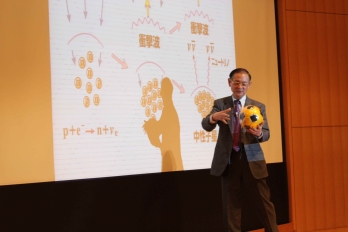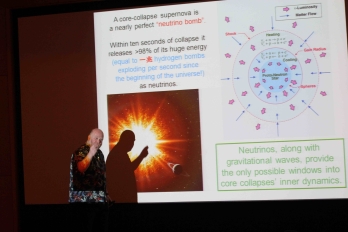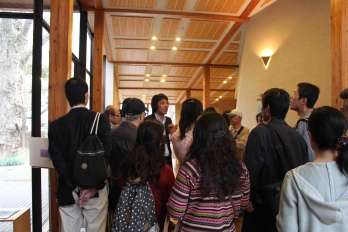Public lecture “Look into the Fate and Nature of the Universe from Recent Supernovae Research”

Date of activity: March 29, 2015
More than 200 people crammed into a hall at the University of Tokyo last month to hear the latest behind-the-scenes story of exploding stars, or supernovae.
Three researchers from the Kavli Institute for the Physics and Mathematics of the Universe (Kavli IPMU) working at the frontline of supernovae research explained the bigger meaning behind these visually stunning explosions from a theoretical point of view, and an experimental point of view.
To begin with, Principal investigator, Project Professor and Hamamatsu Professor Ken’ichi Nomoto introduced the history of supernovae studies.
The supernova explosion mechanism was explained with a tennis ball and a soccer ball. He told us how the elements that make up our bodies were created in the exploding stars. He also showcased the latest research developments, including how the Subaru Telescope in Hawaii managed to detect an echo of a 400-year-old supernova. At the end, his forecast of how we would see the Betelgeuse supernova in the near future was introduced.
Then, Professor Mark Vagins talked about his research with neutrinos. Referencing University of Tokyo Special University Professor Emeritus Masatoshi Koshiba’s Nobel Prize winning observation of neutrinos from a supernova using the Kamiokande detector buried under Japanese Alps, Vagins explained that the majority of exploding energy is taken out by this invisible neutrino which gives us a clue what is happening in the core of the exploding star. He also introduced his latest development of a new instrument to detect neutrinos from Betelgeuse supernova which may happen in the near future.
Finally, Project Assistant Professor Nao Suzuki told a story about the discovery of dark energy using supernova. The story begins from the dinosaur extinction. The researchers seeking the cause of dinosaur extinction happened to develop a technology to find a supernova which turned out to be a standard candle to measure the distances. It coincided with the time when large telescopes were being built which stretched the searches of supernova in the distant universe, and as a result, two groups independently discovered the accelerating expansion of the universe in the late 1990s. Suzuki also introduced ongoing projects using the Subaru Telescope and upcoming satellite projects to study this mysterious dark energy.
After the public lecture, participants chatted with the researchers, providing the perfect end to the event over tea and cookies.
This public lecture “Look into the Fate and Nature of the Universe from Recent Supernovae Research” was hosted by the Kavli IPMU, and was held at the Yayoi Auditorium Ichijo Hall on 29 March.

Ken’ichi Nomoto uses a soccer ball to explain the mechanism behind a supernova explosion. 
Mark Vagins explains how neutrinos are released following a supernova explosion. 
Nao Suzuki answers questions from participants during tea time.






